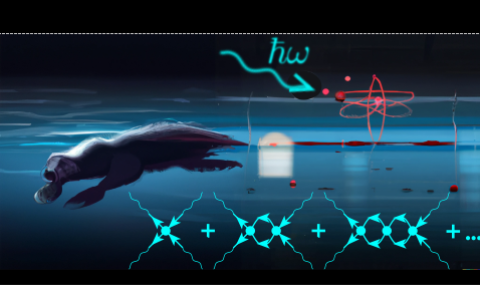Waveguide quantum electrodynamics is an emerging field of quantum optics studying interaction of photons propagating in a waveguide with localized quantum emitters. Depending on the platform, the quantum emitters can be realized as semiconductor quantum dots, quantum solid-state defects, cold atoms, or superconducting qubits. Such systems are promising for quantum information processing, quantum memory applications, generation and detection of quantum light.
The coupling between photons and emitters in a waveguide gives rise to the hybridized excitations, termed as polaritons. While two photons in vacuum propagate independently, two polaritons, propagating in the waveguide, are strongly interacting. This interaction is mediated by the anharmonicity of the atomic potential. Namely, the same two-level atom can not be excited by light twice at the same time. The interactions between polaritons give rise to unusual quantum correlations. Specifically, we predict interaction-induced localization, where the first photon creates a potential well for a second one and vice versa, topologically nontrivial edge states, and interaction-induced quantum chaos. Our findings indicate that even the simplest two-polariton problem in waveguide quantum electrodynamics can demonstrate very diverse physical phenomena. Our current research is focused on studying this system in the strongly excited many-body regime. In addition to the waveguide-coupled systems, we are also interested in polariton-polariton in the clouds of Rydberg atoms (in collaboration with the Light-vs Matter lab of Ofer Firstenberg at Weizmann).

We are also constantly thinking how learn and teach waveguide QED in the best way. Here is a list of problems in theoretical physics aimed at beginners in this field, studying collective light-matter interactions.
Selected publications
Review
- Alexandra S. Sheremet, Mihail I. Petrov, Ivan V. Iorsh, Alexander V. Poshakinskiy, Alexander N. Poddubny, Waveguide quantum electrodynamics: Collective radiance and photon-photon correlations, Rev. Mod. Phys. 95, 015002 ( 2023).
Theory
- Alexander V. Poshakinskiy, Janet Zhong, Alexander N. Poddubny, Quantum chaos driven by long-range waveguide-mediated interactions, Phys. Rev. Lett. 126, 203602 (2021),
- Alexander V. Poshakinskiy, Janet Zhong, Yongguan Ke, Nikita A. Olekhno, Chaohong Lee, Yuri S. Kivshar, Alexander N. Poddubny, “Quantum Hall phases emerging from atom-photon interactions”, Quantum Information 7, 34 (2021),
- Janet Zhong, Nikita A. Olekhno, Yongguan Ke, Alexander V. Poshakinskiy, Chaohong Lee, Yuri S. Kivshar, and Alexander N. Poddubny, “Photon-Mediated Localization in Two-Level Qubit Arrays”, Phys. Rev. Lett. 124, 093604 (2020)
- Yongguan Ke, Alexander V. Poshakinskiy, Chaohong Lee, Yuri S. Kivshar, and Alexander N. Poddubny, “Inelastic scattering of photon pairs in qubit arrays with subradiant states”, Phys. Rev. Lett. 123, 253601 (2019)
In collaboration with experimentalists
- Lee Drori, Bankim Chandra Das, Tomer Danino Zohar, Gal Winer, Eilon Poem, Alexander Poddubny, Ofer Firstenberg, “Quantum vortices of strongly interacting photons”, Science 381, 193 (2023),


